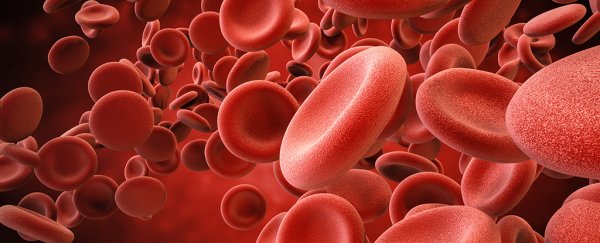Patients who receive intestinal transplants could get more than just a healthy new gut – they could also be getting a new supply of somebody else's blood cells.
Over the past couple of years, researchers have started to notice patients who receive donated bits of intestine also present with what's known as blood chimerism.
This means they not only make their own blood cells, but they also have cells that belong to their donor as well.
This might be expected of any transplanted organ, at least to some degree. But these donor blood cells stick around a while, which at first glance seemed rather odd.
It's long been thought that the only place adult humans make new blood cells is in bone marrow. But this discovery suggests our gut also contains hematopoietic tissue which can pump out a stream of red and white cells into our circulatory system.
While nobody knows exactly how much blood this intestinal tissue contributes, it could be as much as 10 percent of our body's supply. So we're not talking a trivial amount.
To see what happens to these foreign cells over the long term, the discoverers of this strange secondary source kept track of 21 intestinal transplant recipients for five years.
They not only found foreign hematopoietic stem and progenitor cells (HSPCs) in the mucosa of the donated intestine, they identified them in a section of the small intestine, liver, and lymph nodes.
What's more, over time these cells were gradually replaced by the recipient's own blood-building tissues.
On first thought, this should be a serious cause for concern. White blood cells are the infantry of the body's immune system, attacking foreign invaders on sight.
The donated organ isn't seen as a friendly immigrant in the recipient's body, which is why powerful anti-rejection medications are required to dampen their immune response, lest the organ is destroyed.
It stands to reason that white blood cells made by the intestine should also see the recipient's tissues foreign, causing them to attack their body in return in what's known as graft-versus-host disease.
It's why even well-matched bone marrow donations carry the risk of rioting against their new home.
Yet this issue wasn't anywhere near as bad as the researchers had expected. In fact, it seemed as if the opposing factions of white cells had engaged in some sort of diplomatic relations.
"We are clearly showing that there's immunological cross-talk between the two sets of blood cells that protects the transplant from the patient's immune system and protects the patient from the transplant," says research lead Megan Sykes from the Columbia Center for Translational Immunology.
The donor's HSPCs were seemingly being educated in the new body to recognise their new home as 'self', even as they were slowly replaced.
Reflecting back on previous research, this white cell peace summit could be behind a surprising benefit to blood chimerism.
Transplants of intestinal allografts have a high failure rate, of about 50 percent within the first five years. That means if you're one of the lucky ones to even get a transplant, you can flip a coin to see if it'll take.
Given the high load of lymph tissue in the allograft, between 5 and 9 percent of patients will get graft-versus-host disease.
Yet in an earlier study on nine recipients of two different kinds of intestinal transplant, four patients with early moderate to severe rejection also had much lower levels of donor blood cells.
This isn't a huge sample size, admittedly, but the case is growing in favour of donated HSPCs in the intestine reducing the risk of rejection.
Knowing more about this process could be a big win for future transplants.
"It's possible that patients with a high level of donor cells may not require as much immunosuppression as they are currently getting, and reducing immunosuppression could improve outcomes," says Sykes.
Those with serious gut conditions such as Crohn's disease can benefit from donated sections of intestine.
It seems their chances of a better life go up if they get bonus blood production thrown in for no extra cost.
This research was published in Cell Stem Cell.
